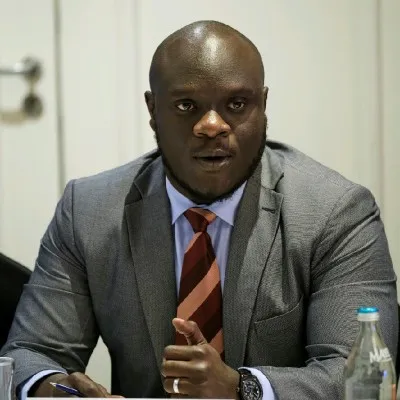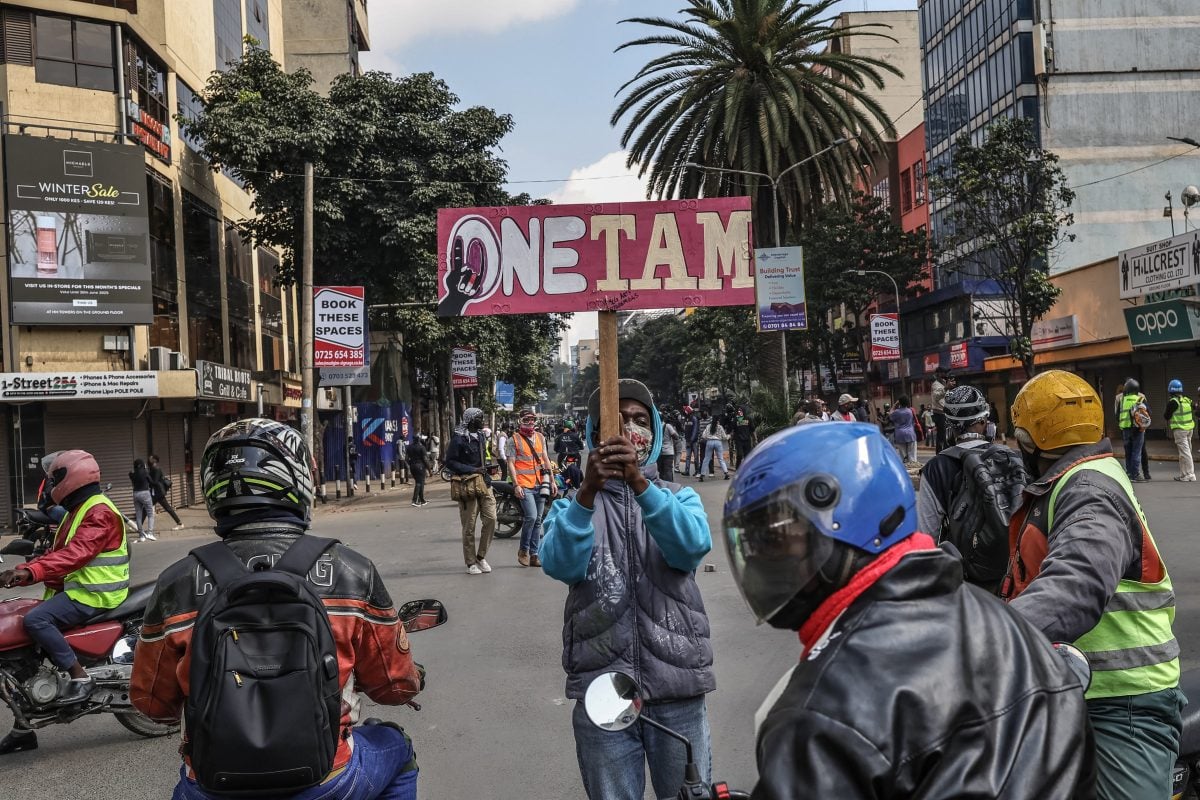On 25 June and 7 July scores of mostly young protestors took to the streets of Nairobi and other urban centres in Kenya to express their frustration with the nation’s government. They called for an end to police brutality and condemned the alleged use of extrajudicial methods to suppress political dissent. They also criticised the government for not doing enough to address youth unemployment, end corruption and waste in the public service and lower the cost of living.
In a familiar yet disturbing pattern, mostly peaceful demonstrations were joined by elements who engaged in running battles with the police, destroyed property and looted businesses. Government buildings, including several police stations, were set ablaze in the ensuing chaos.
The authorities responded with deadly force, resulting in 61 deaths – 21 on 25 June and 40 on 7 July – according to the Kenya National Commission on Human Rights (KNCHR). The country’s national police service disputes these figures, claiming that a total of 42 fatalities were officially recorded in both protests.
Politicians trade blame
In the wake of the July protests President William Ruto condemned the violence and destruction, casting the blame on his political opponents who he accused of “sponsoring” the havoc in a bid to undermine his leadership through undemocratic means.
“We cannot accept mayhem and anarchy to destroy the development we have in this country… this country will not be destroyed by a few people who are impatient and who want to have a change of government using unconstitutional means,” Ruto said at a political rally on 9 July in Nairobi’s Kilimani area.
Politicians opposed to Ruto’s government allege that those who instigated the violence during the protests were deployed by shadowy political operatives acting on secret orders from state officials. The government has categorically denied these claims.
Kenya’s political landscape remains bitterly divided. Opposition figures appear to be coalescing around former deputy president Rigathi Gachagua, who after his impeachment last year emerged as one of the government’s fiercest critics – trading places with long-time opposition leader Raila Odinga, whose Orange Democratic Movement (ODM) party entered into a co-operation pact with Ruto.
Amid these political shifts, some observers fear that the real issues that drove young Kenyans to the streets will be forgotten, along with accountability for those on both sides responsible for the mayhem that marred the protests.
Dashed expectations
John Wahome, a mathematics lecturer at Laikipia University and regular opinion columnist for Kenya’s The Standard, tells African Business that he was among the millions of Kenyan voters who looked forward to Ruto’s ascent to the presidency in 2022 with great expectancy. Things have, however, turned out quite differently.
“Ruto took over amid great goodwill and a truly triumphant mood in most of the country. I was as expectant as anyone else with the hope of a new dispensation steered by fresh commoners like me – self-declared ‘hustlers’,” Wahome says.
On the campaign trail, Ruto pledged to empower Kenya’s common folk – including the so-called “‘hustlers” – and to take on its political and business elite. After winning the election, however, he angered supporters with a move to raise taxes, claiming that the previous administration, which he was a part of as deputy president for two terms, had racked up unsustainably high levels of debt.
It’s not just Ruto’s economic policies that have riled the public, Wahome argues. Another major concern is his refusal to attentively listen to the public or to accept criticism.
This, Wahome says, is a key issue for many young people in the country who still “do not feel heard” despite marching in the streets.
“I have had many opportunities to interact with the young minds and hear their perspectives. I can emphatically say that what they crave are leaders capable of listening to them actively, giving them hope and reassurance in a national arena with dwindling economic opportunities.
“They need leadership that will tell them the truth and keep promises made to them. Most of all, they need visionaries who will steward national resources faithfully without any proclivities to graft and nepotism. For a president, they need someone who can honestly tackle the troubling questions,” Wahome says.
A test of investor confidence
This is not the first time in Ruto’s presidency that Kenya has been rocked by protests. Last year, young Kenyans took to the streets in opposition to proposed tax hikes, resulting in events that mirrored this year’s unrest. There was widespread destruction of property, looting and deadly clashes with the police. In the aftermath the government pledged to look into the grievances raised, just as they promised to do this year.
However, many of the protestors’ demands – both this year and last – have gone unmet, raising fears of a recurrence of deadly anti-government protests in the future. Experts warn that a sustained wave of
such protests could pose a significant test for investor confidence and economic stability.
“Investor sentiment is currently a bit cautious,” says Brian Waruru, manager of international tax and transaction services at consultancy EY (previously Ernst & Young), in reaction to the July protests. He tells African Business that investors are weighing the risks of putting money into the country amid the rising political temperature.
“It’s been three years of the current government and we already have an electoral mood. From an investor’s perspective it brings investment delays, and businesses pause expansion or hiring in anticipation of political uncertainty,” he says. Political pressure can also lead to what Waruru describes as “policy volatility,” which is when governments reverse major policy decisions to appease the public. This can make it harder for businesses to make long-term plans, limiting the flow of investments into an economy.
A fiscal fix?
Beyond finding a peaceful resolution to the growing political unrest, Waruru argues that Kenya needs a fiscal fix to boost investor confidence. The country’s debt has ballooned over the past decade, moving from 41% of GDP in 2014 to 73% in 2023, according to Statista, as the government borrowed to finance infrastructure development. This has led to a sharp increase in debt service costs and a widening budget deficit, compelling the state to cut unnecessary spending and focus more on mobilising additional revenues.
“We have a budget of Sh4.2 trillion ($32.5bn) but our revenue is Sh3.3 trillion ($25.5bn), so we still have a deficit of about Sh800bn ($6.2bn) that the government is trying to sort out,” Waruru says. He notes that, to boost revenues and cut the deficit, the government is looking to expand the tax base, seal leakages and improve tax administration – a softening of last year’s controversial tax hikes that sparked protests.
“We can see a policy shift in the current Finance Act 2025, from increasing taxes to administrative measures that they’re trying to introduce so that they can expand the tax base,” Waruru says, citing the increased use of digital technology by the taxman to improve efficiency and seal revenue leakages.
Sébastien Conway, CEO of Dublin-based Ascoria Technologies, tells African Business that the problem with revenue leakages is that the “people who are actually paying tax end up paying more tax, and people who are avoiding it keep avoiding it.” He says that digital tools can help to end leakages and promote transparency.
In addition to improving tax administration, Kenyan authorities are also looking at improving revenue collection from burgeoning and productive sectors like the digital economy. In December, the country introduced the Significant Economic Presence (SEP) Tax, aimed at addressing the challenges of taxing the digital landscape.
This new tax framework seeks to capture revenue from tech companies that generate substantial income from Kenya without maintaining a physical presence in the country. This includes services provided through digital marketplaces such as e-commerce sites, social media channels, streaming services, ride-hailing apps and freelance platforms.
Conway welcomes this move but cautions that a balanced and consultative approach to implementation is needed to promote fairness for all players in the digital economy.
“In terms of enacting these laws and regulations, it needs to be non-discriminatory. They can’t be targeted at just certain groups or companies within the digital economy.
“This is now a whole subset of the economy that needs to be addressed in a certain, fair and equitable manner. Many countries don’t want to throttle startups or innovation, so these factors need to be taken into account.”
Sentiment eclipses economic wins
Ruto’s broader efforts to stabilise the Kenyan economy have yielded some positive results. The shilling has strengthened, thanks in part to a $1.5bn bond sale in February 2024 and a steady build up in foreign exchange reserves, which reached an all-time high of $11.201bn on 10 July, according to the Central Bank of Kenya (CBK). Meanwhile, inflation has slowed and the cost of government borrowing has fallen along with local interest rates, creating a degree of fiscal manoeuvrability.
However, these wins have been overshadowed by the negative sentiment surrounding Ruto’s presidency and his government’s violent crackdown on protestors. Some commentators have gone so far as suggesting that he should reconsider running for re-election in 2027.
“Given the damage to Mr Ruto’s reputation over the past three years, a less tainted successor would have a better chance of getting the reforms Kenya needs. So the president should not stand for re-election in 2027,” the Economist magazine wrote in the wake of the protests.
For Wahome, the question of whether or not Ruto will stand for re-election in 2027 is secondary to a more pressing concern: the need for Kenya to embark on an extensive overhaul of its political system to narrow the gap between the leaders and the led.
“Most Kenyans now live for the day they will become politicians to start making a real living near the till. This explains our unending campaign mood and the snowballing of politics into a huge and unending national preoccupation.”
Want to continue reading? Subscribe today.
You've read all your free articles for this month! Subscribe now to enjoy full access to our content.
Digital Monthly
£8.00 / month
Receive full unlimited access to our articles, opinions, podcasts and more.
Digital Yearly
£70.00 / year
Our best value offer - save £26 and gain access to all of our digital content for an entire year!

 Sign in with Google
Sign in with Google 



